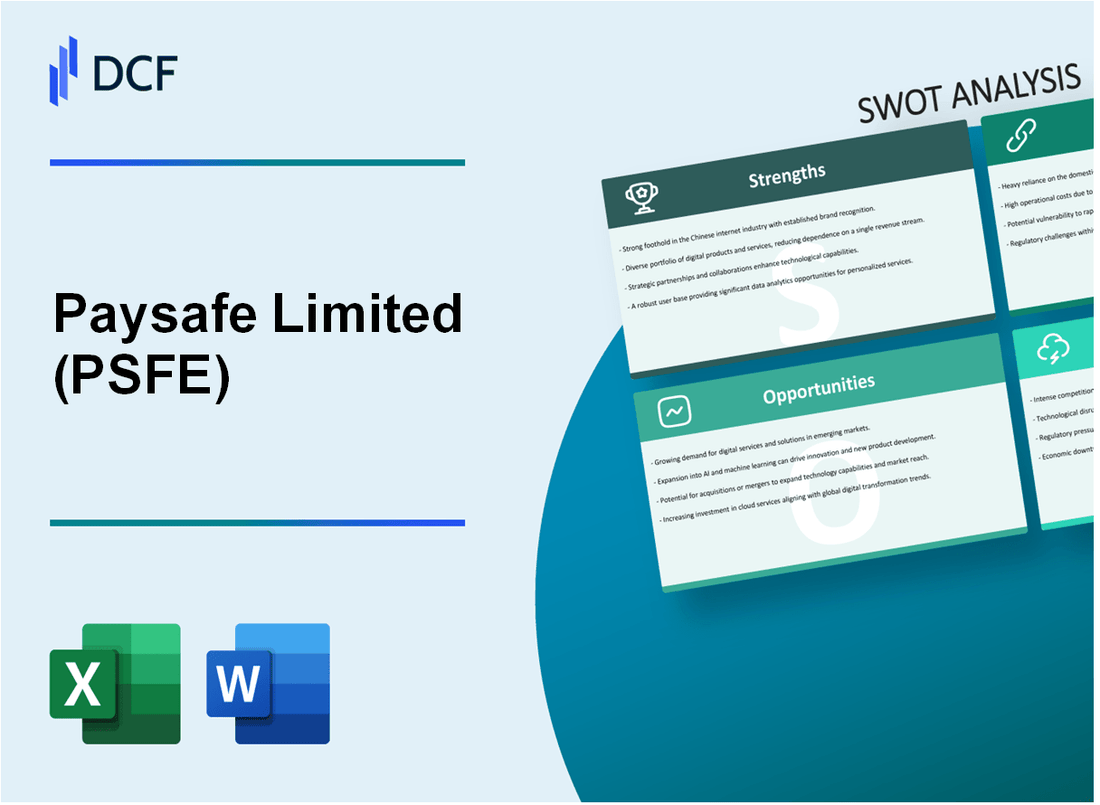
|
Paysafe Limited (PSFE): SWOT Analysis [Jan-2025 Updated] |

Fully Editable: Tailor To Your Needs In Excel Or Sheets
Professional Design: Trusted, Industry-Standard Templates
Investor-Approved Valuation Models
MAC/PC Compatible, Fully Unlocked
No Expertise Is Needed; Easy To Follow
Paysafe Limited (PSFE) Bundle
In the fast-evolving digital payments landscape, Paysafe Limited (PSFE) stands at a critical juncture, navigating complex market dynamics with its innovative payment solutions. As a global digital payment platform, the company is strategically positioning itself to leverage emerging technologies and market opportunities while addressing significant challenges in the competitive fintech ecosystem. This comprehensive SWOT analysis reveals the intricate balance of Paysafe's strengths, weaknesses, potential growth trajectories, and potential market disruptors that will shape its strategic direction in 2024 and beyond.
Paysafe Limited (PSFE) - SWOT Analysis: Strengths
Global Digital Payment Platform
Paysafe operates in 28 countries across North America, Europe, and Asia-Pacific. The company processed $127 billion in total transaction volume in 2022. Online gambling segment represented 43% of total payment volume.
| Geographic Presence | Transaction Volume | Market Segments |
|---|---|---|
| 28 Countries | $127 Billion (2022) | Online Gambling, E-commerce, Digital Wallets |
Diverse Payment Solutions
Paysafe offers comprehensive payment technologies across multiple channels:
- Credit Card Processing
- ACH Transactions
- Digital Wallet Services
- Prepaid Payment Solutions
| Payment Solution | Annual Transaction Value |
|---|---|
| Credit Card Processing | $52.3 Billion |
| Digital Wallet Transactions | $38.7 Billion |
Technological Infrastructure
Advanced security capabilities include:
- Machine learning fraud prevention
- Real-time transaction monitoring
- PCI DSS Level 1 Compliance
Strategic Partnerships
Paysafe maintains partnerships with:
- Visa (Transaction volume: $42.6 Billion)
- Mastercard (Transaction volume: $38.9 Billion)
- Major global e-commerce platforms
Revenue Streams
| Payment Vertical | Annual Revenue | Growth Rate |
|---|---|---|
| Online Gambling | $512 Million | 8.3% |
| E-commerce | $387 Million | 6.7% |
| Digital Wallets | $276 Million | 5.9% |
Paysafe Limited (PSFE) - SWOT Analysis: Weaknesses
Significant Financial Volatility and Inconsistent Profitability
Paysafe reported a net loss of $86.1 million in Q3 2023, compared to a net loss of $42.8 million in the same quarter of 2022. The company's revenue for Q3 2023 was $385.4 million, representing a 3.4% decrease from the previous year.
| Financial Metric | 2022 Value | 2023 Value |
|---|---|---|
| Net Loss | $42.8 million | $86.1 million |
| Revenue | $399 million | $385.4 million |
High Debt Levels and Financial Restructuring Challenges
As of Q3 2023, Paysafe's total debt stood at $1.1 billion, with significant ongoing restructuring efforts to manage its financial obligations.
- Long-term debt: $892 million
- Short-term debt: $208 million
- Debt-to-equity ratio: 3.7
Limited Market Share
Paysafe's market share in the global payment processing industry remains significantly smaller compared to competitors:
| Competitor | Market Share | Annual Revenue |
|---|---|---|
| PayPal | 29.8% | $27.5 billion |
| Stripe | 15.2% | $1.5 billion |
| Paysafe | 1.7% | $1.45 billion |
Regulatory Complexities
Paysafe operates in 23 international markets, facing diverse regulatory challenges:
- Compliance costs: $42.3 million in 2023
- Regulatory investigations: 3 ongoing cases
- Potential regulatory fines: Estimated $15-20 million
Merger and Acquisition Integration Challenges
Following the 2021 SPAC merger, Paysafe continues to experience integration challenges:
- Integration-related expenses: $67.2 million in 2023
- Workforce reduction: 12% of total employees
- System consolidation costs: $22.5 million
Paysafe Limited (PSFE) - SWOT Analysis: Opportunities
Expanding Digital Payments Market in Emerging Economies and Developing Regions
According to the World Bank, digital payments in emerging markets are projected to grow at a 13.4% CAGR from 2021 to 2026. Key regions with significant potential include:
| Region | Digital Payment Market Size (2023) | Projected Growth Rate |
|---|---|---|
| Latin America | $48.2 billion | 15.7% |
| Southeast Asia | $62.5 billion | 16.3% |
| Middle East | $37.8 billion | 14.9% |
Growing Demand for Online Gambling and Digital Entertainment Payment Solutions
The global online gambling market is expected to reach $127.3 billion by 2027, with key statistics:
- Online sports betting market: $83.6 billion in 2023
- Digital casino segment: $36.5 billion in 2023
- Mobile gambling revenue: 67.2% of total online gambling market
Increasing Adoption of Contactless and Mobile Payment Technologies
Contactless payment market insights:
| Metric | 2023 Value | 2027 Projection |
|---|---|---|
| Global Contactless Payment Market | $18.4 trillion | $27.6 trillion |
| Mobile Wallet Users Worldwide | 3.4 billion | 4.8 billion |
Potential for Strategic Partnerships in Fintech and Digital Commerce Sectors
Fintech partnership opportunities:
- Global fintech investment: $135.6 billion in 2023
- Cross-border payment partnerships increasing by 22.5% annually
- E-commerce payment integration market: $45.3 billion
Developing Advanced Blockchain and Cryptocurrency Payment Infrastructure
Cryptocurrency payment market dynamics:
| Cryptocurrency Metric | 2023 Value | 2026 Projection |
|---|---|---|
| Global Crypto Payment Market | $2.1 trillion | $4.7 trillion |
| Blockchain Payment Solutions | $3.8 billion | $8.9 billion |
Paysafe Limited (PSFE) - SWOT Analysis: Threats
Intense Competition in Digital Payments and Financial Technology Sectors
The digital payments market is projected to reach $10.45 trillion by 2025, with intense competition from major players.
| Competitor | Market Share (%) | Annual Revenue ($M) |
|---|---|---|
| PayPal | 35.7 | 27,518 |
| Stripe | 14.2 | 12,712 |
| Square | 10.5 | 17,654 |
Rapidly Changing Regulatory Landscape
Global regulatory compliance costs for financial technology companies are estimated at $181 billion annually.
- PSD2 compliance requirements in Europe
- KYC/AML regulations
- Data privacy standards
Potential Cybersecurity Risks
Global cybercrime damages are projected to reach $10.5 trillion annually by 2025.
| Type of Cyber Threat | Average Cost per Breach ($) | Frequency |
|---|---|---|
| Payment Fraud | 4.12 million | Every 39 seconds |
| Data Breach | 9.44 million | 1 every 11 seconds |
Economic Uncertainties
Global digital payment transaction value expected to reach $9.47 trillion in 2024.
- Inflation rate impact: 3.4% globally
- Consumer spending volatility: ±5.2%
- Digital transaction volume fluctuations
Emerging Alternative Payment Platforms
Cryptocurrency and blockchain payment market projected to reach $1.89 trillion by 2028.
| Alternative Payment Platform | User Base | Transaction Volume ($B) |
|---|---|---|
| Cryptocurrency | 420 million | 15,800 |
| Decentralized Finance | 6.8 million | 1,250 |
Disclaimer
All information, articles, and product details provided on this website are for general informational and educational purposes only. We do not claim any ownership over, nor do we intend to infringe upon, any trademarks, copyrights, logos, brand names, or other intellectual property mentioned or depicted on this site. Such intellectual property remains the property of its respective owners, and any references here are made solely for identification or informational purposes, without implying any affiliation, endorsement, or partnership.
We make no representations or warranties, express or implied, regarding the accuracy, completeness, or suitability of any content or products presented. Nothing on this website should be construed as legal, tax, investment, financial, medical, or other professional advice. In addition, no part of this site—including articles or product references—constitutes a solicitation, recommendation, endorsement, advertisement, or offer to buy or sell any securities, franchises, or other financial instruments, particularly in jurisdictions where such activity would be unlawful.
All content is of a general nature and may not address the specific circumstances of any individual or entity. It is not a substitute for professional advice or services. Any actions you take based on the information provided here are strictly at your own risk. You accept full responsibility for any decisions or outcomes arising from your use of this website and agree to release us from any liability in connection with your use of, or reliance upon, the content or products found herein.
